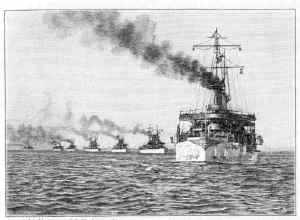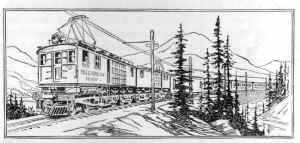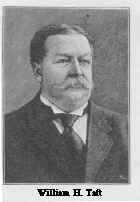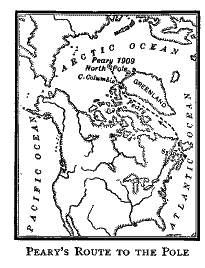Resource Center OLLibrary
|
400 |
|
[1907-1909 |
Wise action saved us from what might have been the destruction
of many great industries employing many workmen.
431. Admission of Oklahoma; Three Important
Laws; Cruise of Our Fleet; Japan; Presidential Election
(1908). During 1907 Congress admitted the state of Oklahoma
(§ 394) -- rich above all others in oil wells. It was formed
by uniting Oklahoma Territory and Indian Territory. This made a
total of forty-six states.

copyright, Underwood & Underwood
OUR FLEET LEAVING HAMPTON ROADS ON ITS VOYAGE ROUND THE WORLD
"Good-by and good luck,"--President Roosevelt's last words to Admiral Evans, commander of the fleet.
Congress also passed three other bills of
great importance. They were the Railway Rate Bill, -- intended to
give greater power to the Interstate Commerce Act (§ 392), --
the Pure Food and Drugs Bill, and the Meat Inspection Bill. The
object of the two last-mentioned laws was to protect the health of
the people and, at the same time, to encourage all dealers to
offer for sale the best and most wholesome foods.
Near the close of the year (1907) a fleet of
twenty of our vessels of war (§ 395), including sixteen
first-class battle ships, left Hampton
|
1907-1909 ] |
|
401 |
Roads, Virginia, on a voyage to San Francisco and Seattle. The
fleet carried 15,000 men. It passed down, along the eastern coast
of South America, and, going through the dangerous Strait of
Magellan, reached San Francisco in May (1908) (see Map facing p.
380). Visits were paid to the northern Pacific coast and to
Hawaii, Manila, Japan, China, and Australia. The fleet then passed
through the Suez Canal into the Mediterranean, and, before leaving
for home, furnished relief to the earthquake sufferers in southern
Italy (1909). The total distance covered was estimated at about
40,000 miles. Never before in the history of the world had so
large a fleet undertaken so long a voyage. It showed many nations
our power upon the Pacific, and it was good for them and for us
that they did see it. One such effect appeared when the Japanese
minister at Washington and our Secretary of State pledged
themselves to endeavor to maintain peace in the Pacific between
America and Japan and to follow the policy of the late Secretary
Hay (§ 424) in doing justice to the rights of China.
Meanwhile the Democratic party had nominated
William J. Bryan for the presidency and the Republican party had
nominated and elected William H. Taft.
432. Summary. President Roosevelt
originated the important movement which declared that the soil,
forests, mines, quarries, and streams of the nation should be used
for the good of the whole people, and should be safeguarded
against waste and destruction.
Side by side with this great undertaking, the
American people were endeavoring to make improvements in saving
health, time, and life. Their resolute and helpful spirit was
likewise shown in the way they met such calamities as the
earthquake and fire at San Francisco.
Other noteworthy events were the admission of
the State of Oklahoma, the passage of the Railway Rate Bill
dealing with commerce between the states, and the enactment of
laws to secure pure-food supplies and pure drugs and
medicines.
Finally, one of the most interesting occurrences
of Mr. Roosevelt's presidency was the brilliant success of the
voyage of the fleet of twenty United States war ships round the
world.
|
402 |
|
[1909-1913 |
|
433. Taft's Administration
(Twenty-eighth. President, 1909-1913; how we made a
Remarkable Discovery. Mr. Taft had been President but
little more than a month when an event of great interest
occurred. Commander Robert E. Peary, an officer in the
United States navy, since created |
|
1909-1913 ] |
|
403 |
|
flag, what we may rightfully consider the most
interesting and noteworthy geographical discovery of
modern times.1 |
|
404 |
|
[1909-1913 |
canals, telegraph and telephone lines, electric-light and
electric power plants, together with all other public-service
corporations. Finally, we must count the money deposited in our
National Banks and Trust Companies, and add to it $5,000,000,000,
and more, of the people's earnings held by Savings Banks
(including the Government Postal Savings Banks, established in
1911). Having done this, we shall realize that America then stood
at the head of the richest nations of the world.1
In this connection we see, too, that while our
numbers and our wealth have grown vastly greater, our means for
rapid transportation and communication have also gained in very
marked degree.
In addition to the progress we have made in
extending steam railways (§ 255) and telegraph and telephone
lines (§ 284), we have built many thousand miles of electric
railways (§ 373). These electric roads form a vast network of
cheap and convenient transit for the inhabitants of cities, towns,
and farming districts.
Besides the lines of steam cars and electric
cars owned and operated by companies, our people possess an
immense number of private cars or automobiles. These vehicles,
aside from their use for pleasure riding, enable an increasing
number of men to carry on their business in cities, while they
have their homes in the country.
On the other hand, if we go into the country, we
find that many farmers are taking advantage of these convenient
machines. The tiller of the soil who owns a "gasoline horse" is
able to carry his light produce to market, a score of miles away
from his farm, and he can also use that "horse" to do certain
kinds of farm work. If he prefers a larger and more powerful
machine, he can seed, cultivate, and harrow the soil, and he can
also haul heavy loads of grain long distances.2 He does
this as easily as city
1 Estimates rated the
wealth of Germany in 1910 at $60,000,000,000, that of France at
$65,000,000,000, that of the British Isles at $80,000,000,000, and
that of the United States at $142,000,000,000; in 1912 the Census
Bureau at Washington estimated our wealth at over
$187,000,000,000. Since then some authorities consider that it has
risen to a much higher figure -- $220,000,000,000 (unofficial
estimate in 1917). See World Almanac for 1920, p. 508.
2 Automobile machines are now
employed, to a considerable extent, for plowing, mowing,
thrashing, and doing other kinds of heavy farm work. Some large
landowners in the West practically keep no horses, but only
machines. The total number of automobiles registered in the United
States in 1915 was 2,000,000; the present number is estimated at
over 6,000,000.
|
1909-1913 ] |
|
405 |
teamsters drive their auto-trucks, piled high with boxes and
bales, from steamship docks to warehouses.
The steam locomotive, which made its first trip
(in this country) nearly a hundred years ago, revolutionized the
transportation of passengers and freight (§ 254). To-day
electric cars and automobiles are accomplishing a second
revolution.1 In time their work may show results as
great as that of steam. Even now we must thank automobiles for the
good roads they have induced us to build and for the Lincoln and
Dixie Highways.2
In this connection attention should be called to
the fact that the completion of the Panama Canal3 from
ocean to ocean (§ 425)

ELECTRIC TRAIN IN THE ROCKIES
(see Map facing p. 380, also p. 407) opens up new sea routes.
It is admitted by public men everywhere that these routes cannot
fail to have very important effects on the trade and commerce of
the United States and of other great nations of the world.
1 The use of
electricity for propelling trains on steam railways has made
considerable progress. Such trains are in operation through the
Hoosac and other tunnels, and also between New York City and New
Haven, Connecticut. In recent years the use of these motors has
been greatly extended, especially through the Rocky Mountains.
2 The great Lincoln Highway, now in
large measure completed, extends from the Atlantic to the Pacific
-- connecting New York City with San Francisco; while the great
Dixie Highway, when completed, will connect New Orleans, and other
important cities of the South, with Chicago and other leading
cities of the North.
3 The Panama Canal with its
approaches is 50 miles long; it can be used by the largest
vessels. The artificial lake, created by the Gatun Dam on the
Chagres River, is over 24 miles in length, and the Culebra Cut,
through the Culebra Hills, is 9 miles long. The total cost of the
canal was estimated at about $400,000,000.
 a
Rear Admiral, set out very early in the spring, from the
shore of the Arctic Ocean, on an exploring expedition
northward across the ice (see Map on opposite page).
Toward the end of the first week in April he succeeded in
getting to a point far beyond that which any previous
explorer had attained. No land was in sight; nothing, in
fact, but a seemingly endless expanse of frozen sea.
a
Rear Admiral, set out very early in the spring, from the
shore of the Arctic Ocean, on an exploring expedition
northward across the ice (see Map on opposite page).
Toward the end of the first week in April he succeeded in
getting to a point far beyond that which any previous
explorer had attained. No land was in sight; nothing, in
fact, but a seemingly endless expanse of frozen sea. tariff
law (§ 406). President Taft stated that he was
convinced that it reduced the duties on several hundred
classes of imported goods. Many people, however, both
Democrats and Republicans, felt dissatisfied with the
result and called for greater and more extended
reductions. Congress passed several bills securing some
of these reductions, that on wool and woolen goods being
the most important, but the President considered it his
duty to veto them.
tariff
law (§ 406). President Taft stated that he was
convinced that it reduced the duties on several hundred
classes of imported goods. Many people, however, both
Democrats and Republicans, felt dissatisfied with the
result and called for greater and more extended
reductions. Congress passed several bills securing some
of these reductions, that on wool and woolen goods being
the most important, but the President considered it his
duty to veto them.


